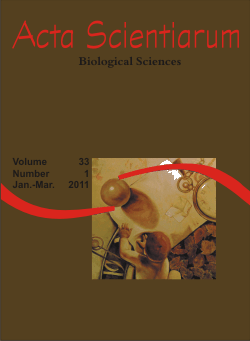<b>Acute toxicity of pyrazosulfuron-ethyl and permethrin to juvenile <em>Litopenaeus vannamei</em></b> - doi: 10.4025/actascibiolsci.v33i1.6974
Keywords:
Toxicology, pesticides, shrimp culture, Litopenaeus vannamei
Abstract
The objective of this study was to determine the LC50 (96h) of two pesticides: Sirius® 250 SC herbicide of the pyrazosulfuron-ethyl group, and Talcord® insecticide of the permethrin group, on juvenile Litopenaeus vannamei. Shrimp total hemocyte count (THC) was also determined as an indication of physiological alterations caused by the pesticides. Juvenile shrimp (5.0 ± 0.5 g) were exposed to the following concentrations: 0, 0.1, 1.0, 10, 100 and 1000 µg L-1 Sirius® 250 SC; and 0, 0.001, 0.01, 0.1, 1.0 and 10 µg L-1 Talcord®. The Talcord® LC50 (96h) was of 0.00933 µg L-1 or 9.33 ng L-1. There were no significant changes in the THC between control and test groups. No Sirius® 250 SC concentrations tested killed more than 50% of the shrimp; therefore, the herbicide was considered not toxic to the juveniles. However, the THC showed significant differences between the control and test groups, suggesting sublethal effects to L. vannamei juveniles. According to the results, the insecticide Talcord® is highly lethal for L. vannamei and the herbicide Sirius® 250 SC was not lethal in the concentrations tested but showed sublethal effects as lower THC. The results demonstrate the risks involved in farming L. vannamei shrimp near rice cultures where these pesticides are routinely used.Downloads
Download data is not yet available.
Published
2011-02-08
How to Cite
Mello, G. L. de, Amaral Júnior, H., Garcia, S., & Vinatea, L. (2011). <b>Acute toxicity of pyrazosulfuron-ethyl and permethrin to juvenile <em>Litopenaeus vannamei</em></b> - doi: 10.4025/actascibiolsci.v33i1.6974. Acta Scientiarum. Biological Sciences, 33(1), 1-6. https://doi.org/10.4025/actascibiolsci.v33i1.6974
Issue
Section
Aquiculture and Fisheries Resources
DECLARATION OF ORIGINALITY AND COPYRIGHTS
I Declare that current article is original and has not been submitted for publication, in part or in whole, to any other national or international journal.
The copyrights belong exclusively to the authors. Published content is licensed under Creative Commons Attribution 4.0 (CC BY 4.0) guidelines, which allows sharing (copy and distribution of the material in any medium or format) and adaptation (remix, transform, and build upon the material) for any purpose, even commercially, under the terms of attribution.
Read this link for further information on how to use CC BY 4.0 properly.
0.6
2019CiteScore
31st percentile
Powered by 

0.6
2019CiteScore
31st percentile
Powered by 











1.png)




3.png)













